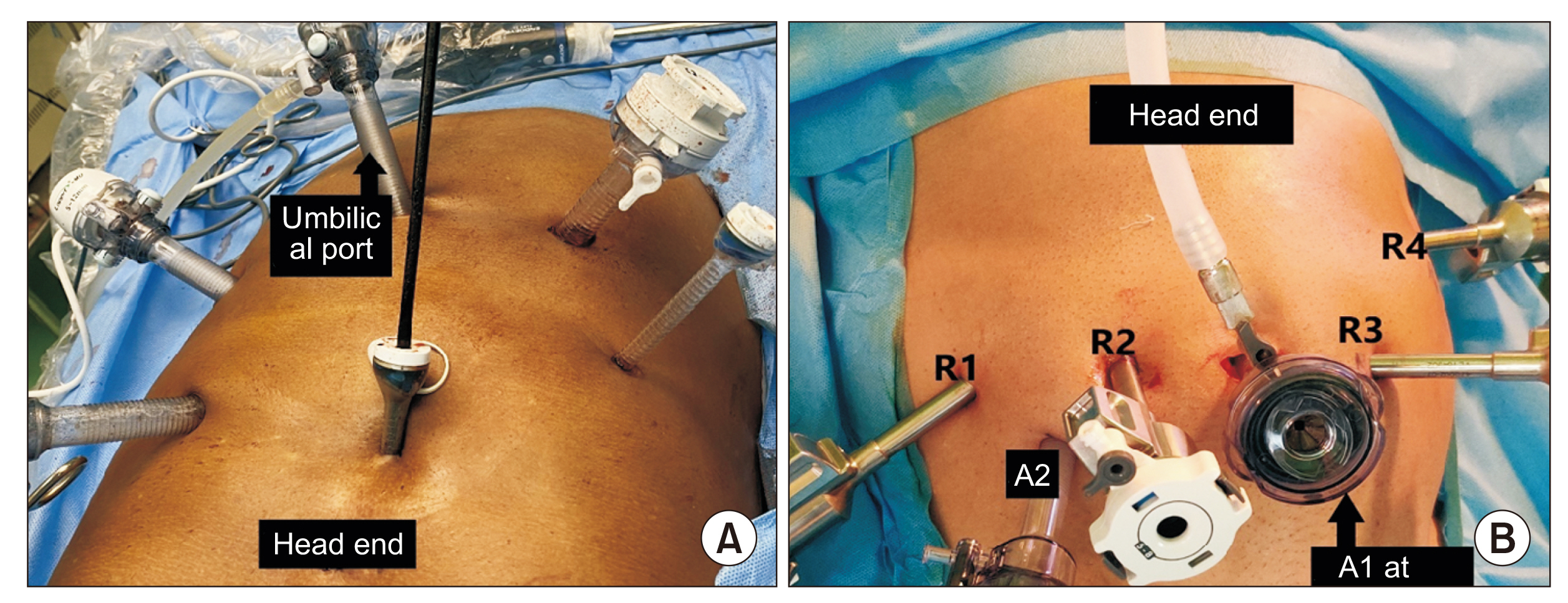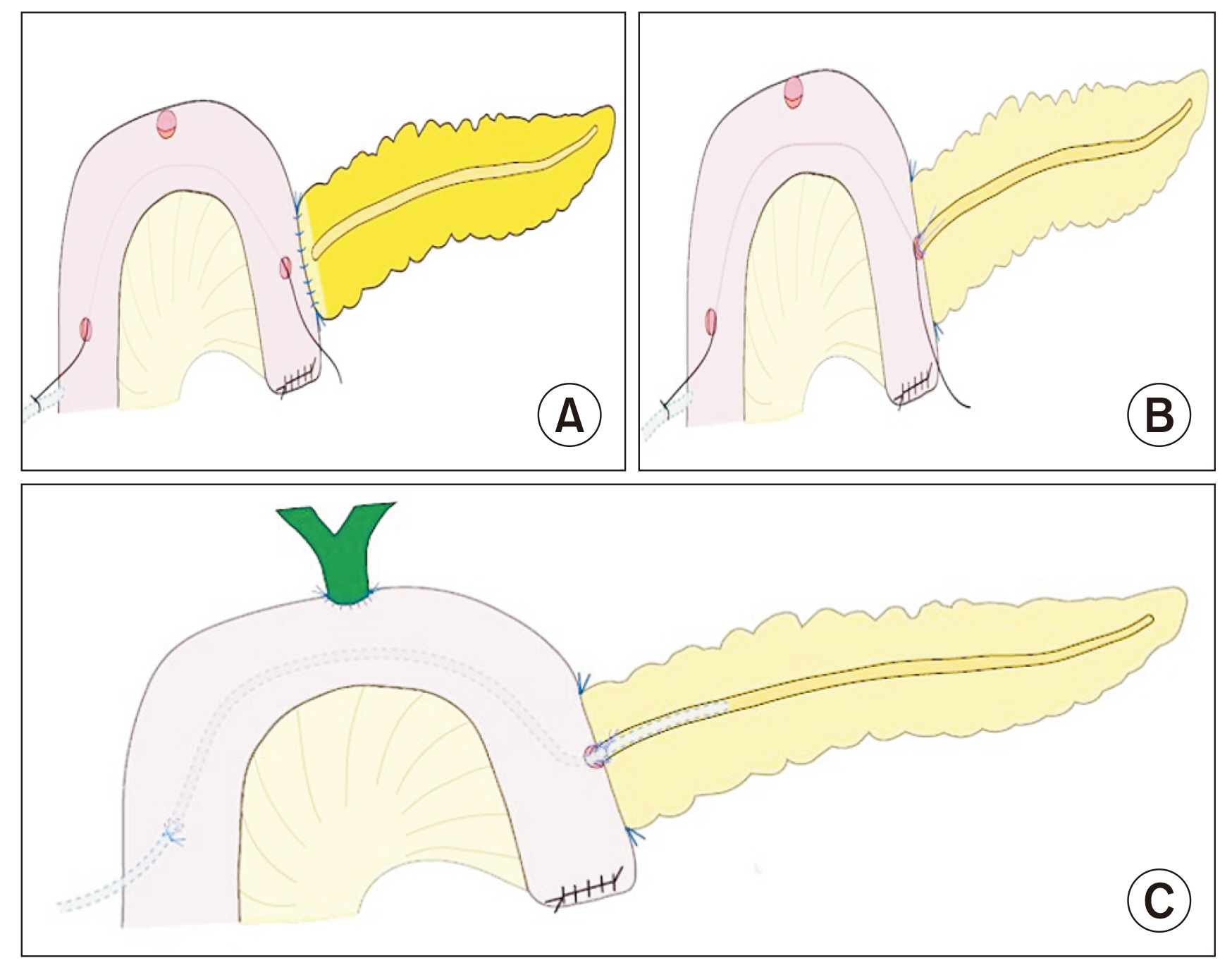Ann Hepatobiliary Pancreat Surg.
2023 May;27(2):211-216. 10.14701/ahbps.22-098.
External pancreatic ductal stenting in minimally invasive pancreatoduodenectomy: How to do it?
- Affiliations
-
- 1Department of Surgical Gastroenterology, Jawaharlal Institute of Postgraduate Medical Education and Research (JIPMER), Puducherry, India
- 2Department of Surgical Gastroenterology, Siksha O Anusandhan University Institute of Medical Sciences and SUM Hospital, Bhubaneswar, Odisha, India
- KMID: 2542586
- DOI: http://doi.org/10.14701/ahbps.22-098
Abstract
- It has been shown that external pancreatic ductal stenting (EPDS) can reduce the incidence of clinically relevant postoperative pancreatic fistula. Although studies have described EPDS in open pancreaticoduodenectomy (PD), EPDS in minimally invasive PD has not been reported yet. Thus, the objective of this study was to describe the technique of EPDS in minimally invasive PD. The procedure was performed either laparoscopically or using a robot. Once PD was completed, key steps included triple enterotomy, threading of silk-suture through all enterotomies and exteriorization, completing posterior layer of pancreaticojejunostomy (PJ), railroading stent through preplaced silk-suture, intubation of stent into the pancreatic duct, completion of PJ, followed by hepaticojejunostomy and parietalization of jejunum at the stent exit site. EPDS in PD through a minimally invasive approach can be performed safely in selected cases with either a small-sized pancreatic duct or a soft pancreas.
Figure
Reference
-
1. Sharpe SM, Talamonti MS, Wang CE, Prinz RA, Roggin KK, Bentrem DJ, et al. 2015; Early national experience with laparoscopic pancreaticoduodenectomy for ductal adenocarcinoma: a comparison of laparoscopic pancreaticoduodenectomy and open pancreaticoduodenectomy from the national cancer data base. J Am Coll Surg. 221:175–184. DOI: 10.1016/j.jamcollsurg.2015.04.021. PMID: 26095569.
Article2. Pedrazzoli S. 2017; Pancreatoduodenectomy (PD) and postoperative pancreatic fistula (POPF): a systematic review and analysis of the POPF-related mortality rate in 60,739 patients retrieved from the English literature published between 1990 and 2015. Medicine (Baltimore). 96:e6858. DOI: 10.1097/MD.0000000000006858. PMID: 28489778. PMCID: PMC5428612.3. Crippa S, Salvia R, Falconi M, Butturini G, Landoni L, Bassi C. 2007; Anastomotic leakage in pancreatic surgery. HPB (Oxford). 9:8–15. DOI: 10.1080/13651820600641357. PMID: 18333107. PMCID: PMC2020778.
Article4. Bassi C, Marchegiani G, Dervenis C, Sarr M, Abu Hilal M, Adham M, et al. 2017; The 2016 update of the International Study Group (ISGPS) definition and grading of postoperative pancreatic fistula: 11 Years After. Surgery. 161:584–591. DOI: 10.1016/j.surg.2016.11.014. PMID: 28040257.
Article5. Nahm CB, Connor SJ, Samra JS, Mittal A. 2018; Postoperative pancreatic fistula: a review of traditional and emerging concepts. Clin Exp Gastroenterol. 11:105–118. DOI: 10.2147/CEG.S120217. PMID: 29588609. PMCID: PMC5858541.
Article6. Chen K, Pan Y, Liu XL, Jiang GY, Wu D, Maher H, et al. 2017; Minimally invasive pancreaticoduodenectomy for periampullary disease: a comprehensive review of literature and meta-analysis of outcomes compared with open surgery. BMC Gastroenterol. 17:120. DOI: 10.1186/s12876-017-0691-9. PMID: 29169337. PMCID: PMC5701376.
Article7. Hirono S, Kawai M, Okada KI, Miyazawa M, Kitahata Y, Hayami S, et al. 2019; Modified blumgart mattress suture versus conventional interrupted suture in pancreaticojejunostomy during pancreaticoduodenectomy: randomized controlled trial. Ann Surg. 269:243–251. DOI: 10.1097/SLA.0000000000002802. PMID: 29697455. PMCID: PMC6325750.
Article8. Kantor O, Pitt HA, Talamonti MS, Roggin KK, Bentrem DJ, Prinz RA, et al. 2018; Minimally invasive pancreatoduodenectomy: is the incidence of clinically relevant postoperative pancreatic fistula comparable to that after open pancreatoduodenectomy? Surgery. 163:587–593. DOI: 10.1016/j.surg.2017.12.001. PMID: 29454444.
Article9. Olakowski M, Grudzińska E, Mrowiec S. 2020; Pancreaticojejunostomy-a review of modern techniques. Langenbecks Arch Surg. 405:13–22. DOI: 10.1007/s00423-020-01855-6. PMID: 31975148. PMCID: PMC7036071.
Article10. Hu BY, Wan T, Zhang WZ, Dong JH. 2016; Risk factors for postoperative pancreatic fistula: analysis of 539 successive cases of pancreaticoduodenectomy. World J Gastroenterol. 22:7797–7805. DOI: 10.3748/wjg.v22.i34.7797. PMID: 27678363. PMCID: PMC5016380.
Article11. Callery MP, Pratt WB, Kent TS, Chaikof EL, Vollmer CM Jr. 2013; A prospectively validated clinical risk score accurately predicts pancreatic fistula after pancreatoduodenectomy. J Am Coll Surg. 216:1–14. DOI: 10.1016/j.jamcollsurg.2012.09.002. PMID: 23122535.
Article12. McAuliffe JC, Parks K, Kumar P, McNeal SF, Morgan DE, Christein JD. 2013; Computed tomography attenuation and patient characteristics as predictors of complications after pancreaticoduodenectomy. HPB (Oxford). 15:709–715. DOI: 10.1111/hpb.12037. PMID: 23458275. PMCID: PMC3948539.
Article13. Tranchart H, Gaujoux S, Rebours V, Vullierme MP, Dokmak S, Levy P, et al. 2012; Preoperative CT scan helps to predict the occurrence of severe pancreatic fistula after pancreaticoduodenectomy. Ann Surg. 256:139–145. DOI: 10.1097/SLA.0b013e318256c32c. PMID: 22609844.
Article14. Yardimci S, Kara YB, Tuney D, Attaallah W, Ugurlu MU, Dulundu E, et al. 2015; A simple method to evaluate whether pancreas texture can be used to predict pancreatic fistula risk after pancreatoduodenectomy. J Gastrointest Surg. 19:1625–1631. DOI: 10.1007/s11605-015-2855-7. PMID: 25982120.
Article15. Kawaida H, Kono H, Hosomura N, Amemiya H, Itakura J, Fujii H, et al. 2019; Surgical techniques and postoperative management to prevent postoperative pancreatic fistula after pancreatic surgery. World J Gastroenterol. 25:3722–3737. DOI: 10.3748/wjg.v25.i28.3722. PMID: 31391768. PMCID: PMC6676555.
Article16. Markar SR, Vyas S, Karthikesalingam A, Imber C, Malago M. 2012; The impact of pancreatic duct drainage following pancreaticojejunostomy on clinical outcome. J Gastrointest Surg. 16:1610–1617. DOI: 10.1007/s11605-012-1852-3. PMID: 22383216.
Article17. Patel K, Teta A, Sukharamwala P, Thoens J, Szuchmacher M, DeVito P. 2014; External pancreatic duct stent reduces pancreatic fistula: a meta-analysis and systematic review. Int J Surg. 12:827–832. DOI: 10.1016/j.ijsu.2014.06.008. PMID: 25003575.
Article18. Poon RT, Fan ST, Lo CM, Ng KK, Yuen WK, Yeung C, et al. 2007; External drainage of pancreatic duct with a stent to reduce leakage rate of pancreaticojejunostomy after pancreaticoduodenectomy: a prospective randomized trial. Ann Surg. 246:425–433. discussion 433–435. DOI: 10.1097/SLA.0b013e3181492c28. PMID: 17717446. PMCID: PMC1959348.19. Dong Z, Xu J, Wang Z, Petrov MS. 2016; Stents for the prevention of pancreatic fistula following pancreaticoduodenectomy. Cochrane Database Syst Rev. 2016:CD008914. DOI: 10.1002/14651858.CD008914.pub3.20. Helaly M, iwi D Sr, Alkholaidi WS, Almamlouk R, Elshaer A, Allaboon RM, et al. 2019; Retrograde pancreatic duct stent migration into the biliary tract presenting as a rare early complication of pancreaticoduodenectomy (Whipple procedure). Am J Case Rep. 20:1864–1868. DOI: 10.12659/AJCR.917297. PMID: 31831724. PMCID: PMC6930705.
Article21. Jang JY, Chang YR, Kim SW, Choi SH, Park SJ, Lee SE, et al. 2016; Randomized multicentre trial comparing external and internal pancreatic stenting during pancreaticoduodenectomy. Br J Surg. 103:668–675. DOI: 10.1002/bjs.10160. PMID: 27040594.
Article22. Shin YC, Jang JY, Chang YR, Jung W, Kwon W, Kim H, et al. 2019; Comparison of long-term clinical outcomes of external and internal pancreatic stents in pancreaticoduodenectomy: randomized controlled study. HPB (Oxford). 21:51–59. DOI: 10.1016/j.hpb.2018.06.1795. PMID: 30093143.
Article23. Boggi U, Amorese G, Vistoli F, Caniglia F, De Lio N, Perrone V, et al. 2015; Laparoscopic pancreaticoduodenectomy: a systematic literature review. Surg Endosc. 29:9–23. DOI: 10.1007/s00464-014-3670-z. PMID: 25125092.
Article24. Justo Alonso I, Marcacuzco Quinto A, Caso Maestro O, Jiménez-Romero C. 2018; Anastomotic reconstruction and external drainage of Wirsung's duct as treatment for pancreaticojejunal stenosis following pancreaticoduodenectomy. Cir Esp (Engl Ed). 96:648–652. DOI: 10.1016/j.ciresp.2018.08.003. PMID: 30448151.
Article
- Full Text Links
- Actions
-
Cited
- CITED
-
- Close
- Share
- Similar articles
-
- Laparoscopic pancreaticoduodenectomy in pancreatic ductal adenocarcinoma
- Minimally invasive radical antegrade modular pancreatosplenectomy: routine vs. modified
- Clinical Outcome of Pancreatic Stenting in the Chronic Pancreatitis Associated with Stricture
- Analysis of Long-term Survivors after Pancreatoduodenectomy in the Patients with Pancreatic Cancer
- Margin-negative minimally invasive pancreatoduodenectomy following FOLFIRINOX neoadjuvant chemotherapy in invasive intraductal papillary mucinous neoplasm of pancreas: a case report





